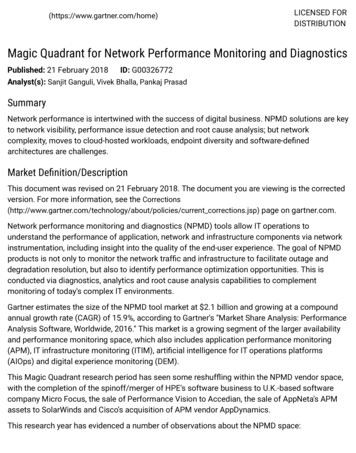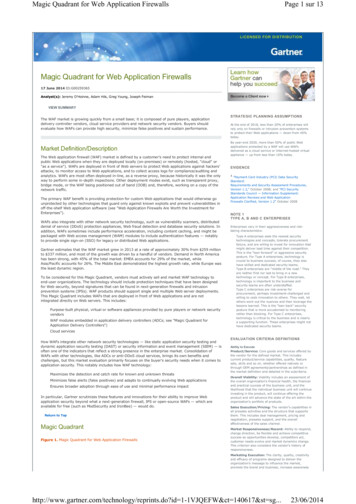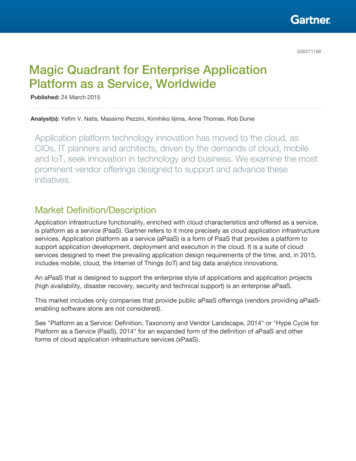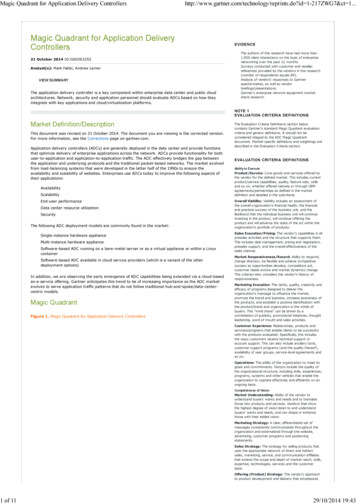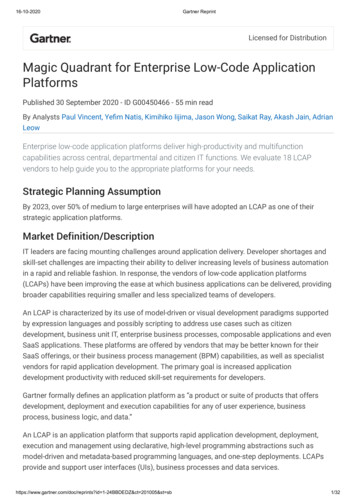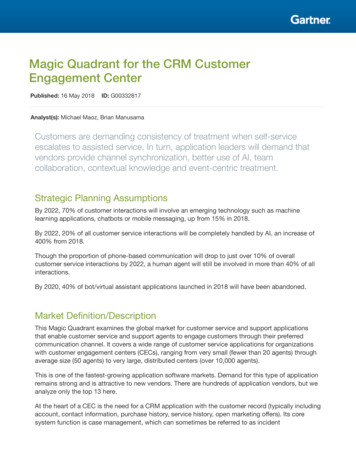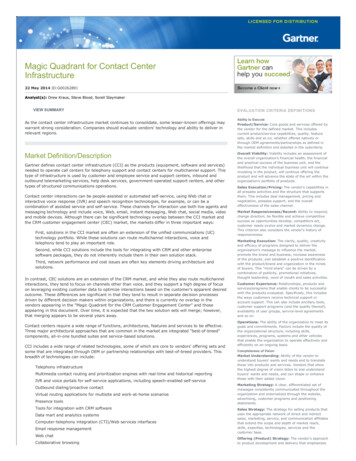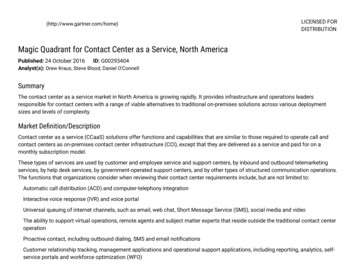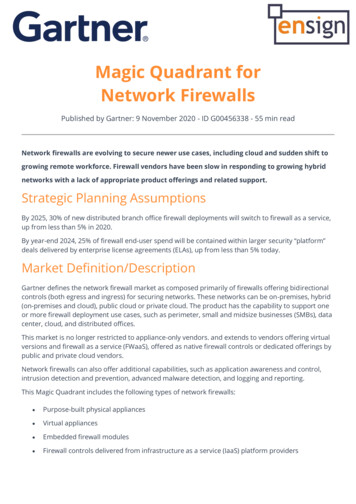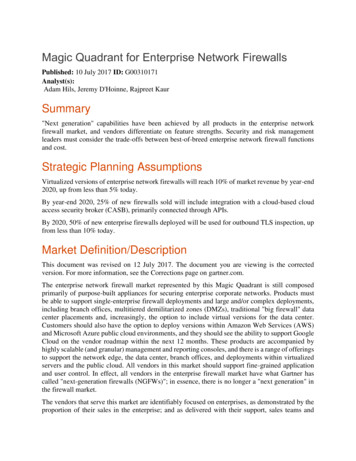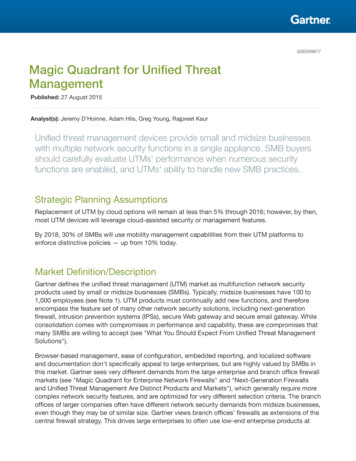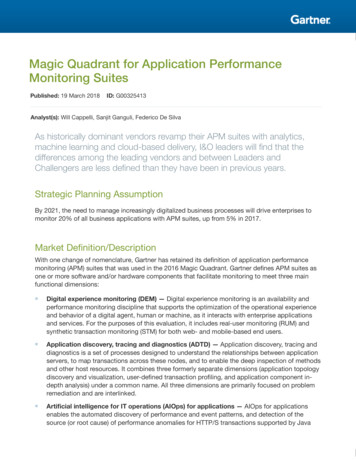
Transcription
Magic Quadrant for Application PerformanceMonitoring SuitesPublished: 19 March 2018ID: G00325413Analyst(s): Will Cappelli, Sanjit Ganguli, Federico De SilvaAs historically dominant vendors revamp their APM suites with analytics,machine learning and cloud-based delivery, I&O leaders will find that thedifferences among the leading vendors and between Leaders andChallengers are less defined than they have been in previous years.Strategic Planning AssumptionBy 2021, the need to manage increasingly digitalized business processes will drive enterprises tomonitor 20% of all business applications with APM suites, up from 5% in 2017.Market Definition/DescriptionWith one change of nomenclature, Gartner has retained its definition of application performancemonitoring (APM) suites that was used in the 2016 Magic Quadrant. Gartner defines APM suites asone or more software and/or hardware components that facilitate monitoring to meet three mainfunctional dimensions: Digital experience monitoring (DEM) — Digital experience monitoring is an availability andperformance monitoring discipline that supports the optimization of the operational experienceand behavior of a digital agent, human or machine, as it interacts with enterprise applicationsand services. For the purposes of this evaluation, it includes real-user monitoring (RUM) andsynthetic transaction monitoring (STM) for both web- and mobile-based end users. Application discovery, tracing and diagnostics (ADTD) — Application discovery, tracing anddiagnostics is a set of processes designed to understand the relationships between applicationservers, to map transactions across these nodes, and to enable the deep inspection of methodsand other host resources. It combines three formerly separate dimensions (application topologydiscovery and visualization, user-defined transaction profiling, and application component indepth analysis) under a common name. All three dimensions are primarily focused on problemremediation and are interlinked. Artificial intelligence for IT operations (AIOps) for applications — AIOps for applicationsenables the automated discovery of performance and event patterns, and detection of thesource (or root cause) of performance anomalies for HTTP/S transactions supported by Java
and .NET application servers. This is accomplished through machine learning, statisticalinference and/or other methods. In 2016, AIOps for applications was referred to as "applicationanalytics" and then as "algorithmic IT operations," before being changed to "AIOps" inmid-2017.Gartner continues to include DEM and AIOps for applications as components of our APM suiteevaluations, while also evaluating them as a separate markets.Page 2 of 25Gartner, Inc. G00325413
Magic QuadrantFigure 1. Magic Quadrant for Application Performance Monitoring SuitesSource: Gartner (March 2018)Gartner, Inc. G00325413Page 3 of 25
Vendor Strengths and CautionsBMCDespite changes in ownership and overall positioning, BMC has long been a player in the APMmarket. Over the past two years, the company has thoroughly revamped its entire monitoringportfolio, placing APM and AIOps at the center of the portfolio's functionality. TrueSight AppVisibilityManager is usually positioned as part of a larger TrueSight Operations Management suite sale,which might also include TrueSight Infrastructure Management and TrueSight Log Analytics.Strengths TrueSight is deeply integrated with the broader set of TrueSight IT management functionality(event management, log analytics, capacity management, etc.) enabling customers to manageevents and capacity as well as perform analytics in an application-centric manner. BMC has a large IT management product portfolio, which allows it several potential entry pointsfor APM product sales. TrueSight synthetic capabilities cover a broad range of applications that can be easilyrecorded from a PC, an emulator or a mobile device.Cautions BMC has demonstrated little ability to sell outside of IT operations, which will become a liabilityas the purchasing influence for APM continues to shift toward developers and lines of business(LOBs). By regularly positioning TrueSight AppVisibility Manager as part of a larger IT operationsmanagement (ITOM) suite, BMC limits the product's visibility to enterprises making stand-aloneAPM decisions. BMC's lack of code tracing for protocols beyond Java and .NET limits the adoption of TrueSightAppVisibility diagnostics capabilities beyond IT operations for new and emerging applications.CA TechnologiesCA Technologies has been in the APM market since the acquisition of Wily Technology in 2006. Lastyear there were significant improvements in the company's APM solutions to address gaps wherethe solution had fallen behind newer market entrants. This was a consequence of a three-year effortto reinvigorate its APM portfolio, over the course of which CA applied for about 20 patents on awide range of APM functionality. CA has once again become a market leader, but with room toimprove overall usability.Page 4 of 25Gartner, Inc. G00325413
Strengths CA combines the ability to discover and present topologies on many tiers of application andinfrastructure stacks, with the possibility of specifying a "projection" of that topology onto highlyspecified roles. CA has extensive sales and support resources that enable varied partnerships and accountdevelopment with enterprise customers. Several large CA enterprise clients with deployments of tens of thousands of APM agentsprovide a "real world" testing ground for future scalability requirements.Cautions Some customers do not find CA sufficiently responsive to problems that occur during theimplementation of new versions or upgrades of suite components. While CA's SaaS-based portfolio deploys easily, the number of products that make up the onpremises APM portfolio elongate time to value for many enterprise customers. AIOps for application functionality needs better integration with the rest of the suite'scapabilities.Cisco (AppDynamics)Founded in 2008 as an APM specialist vendor, AppDynamics offers both an on-premises and SaaSbased APM solution with a common architecture for both deployments. AppDynamics was acquiredby Cisco in March of 2017 as a new software business unit in Cisco's Internet of Things (IoT) andApplications department. The AppDynamics solution includes APM, end-user monitoring andbusiness performance monitoring, with additional capabilities offered through the App iQ platform.The App iQ platform includes the recently released Business iQ capability, which provides businesscentric analytics and dashboards.Strengths An injection of R&D and sales talent from Cisco has improved AppDynamics' time to marketand ability to address the market on a global scale. As AIOps vendors become more competitive with APM, Business iQ provides a differentiatedfunctionality to make AppDynamics' data relevant to the LOBs. AppDynamics' vision to broaden its scope with orchestration and network visibility reflects thedesire of end users to have end-to-end visibility coupled with automation.Cautions The acquisition of AppDynamics by Cisco does not improve the APM company's historicallyweak position with enterprise preproduction (application development) stakeholders.Gartner, Inc. G00325413Page 5 of 25
AppDynamics provides limited support for legacy application environments. Many customers are still unclear about AppDynamics' plans for ultimate alignment andintegration into Cisco's broad and network-focused product lines.CorrelsenseCorrelsense is a privately held APM pure-play vendor founded in 2005, with headquarters in TelAviv, Israel, and Framingham, Massachusetts, and sales and support offices in EMEA and SouthAmerica. Its product, SharePath, provides transaction visibility across much of the entire IT stackand has received several patents for its unique instrumentation approach that goes beyondtraditional application server observability. While the company has succeeded in winning some largedeals in the U.S., Correlsense has little overall visibility in the APM market, as it is keenly focused onprofitability and has had a cautious approach to expansion. The company is generally moving awayfrom field sales to a term-license-oriented, partner-led business model, which includes theleveraging of SaaS-based deliverables.Strengths Correlsense has acquired a reputation for technical excellence and innovative approaches toAPM and related areas of ITOM. SharePath deployment is highly automated. SharePath's approach to instrumentation supports tracing visibility across multiple,heterogeneous environments.Cautions The company has a low profile in a very "noisy" market. Correlsense has a limited direct sales force, which is necessary to be able to sell into complexenterprise environments. There is limited DEM functionality in the product.DynatraceBased on revenue, Dynatrace remains the largest technology provider in the APM suitemarketplace. Despite ownership and corporate structure changes, Dynatrace has been in the APMbusiness since 2005 and visibility of the company for its technology remains high. The firm is oftenfound competing against the other APM market leaders for large, complex enterprise opportunities.Strengths While Dynatrace is privately owned by Thoma Bravo, we believe the firm is fiscally sound withthe largest dedicated sales force in the APM suite market.Page 6 of 25Gartner, Inc. G00325413
The company has heavily invested in cloud, container, and microservices monitoring, as well asin strategic alliances with cloud providers. The eponymous Dynatrace platform (formerly called Ruxit) is based upon a single adaptableand broad-scoped agent technology and supports expanding capabilities beyond core APM toinclude infrastructure monitoring, log analytics and AIOps for root cause analysis.Cautions Dynatrace's growth is on par with other market leaders in absolute value, but its relative growthrate is smaller due to higher revenues. Although the company has clarified its roadmap and positioning, Dynatrace is still suffering fromthe aftereffects of its weak messaging around the transition to the new platform. The companyhas since clarified its strategy, and customers should validate the Dynatrace roadmap with thecompany if any confusion remains. While offering a unified UI as part of the new Dynatrace architecture, customers who remain onthe classic architecture can find the interface difficult to navigate.IBMIBM has been a player in the APM market since 2003, focusing in recent years on enhancing itscore APM functionality with AIOps capabilities and integrating the AIOps-enhanced APM withinfrastructure monitoring. The company has been in the process of updating its sales approach tofocus more on industry-oriented solutions, rather than pure technological or product-driven sales.IBM also focused on expanding the adoption of APM to the DevOps engineer by integrating APMinto its DevOps toolchain, enhancing synthetic response time monitoring, and including embeddedruntime data collector support for cloud microservice runtimes (Java, Node.js, Python, Ruby).Strengths IBM has a considerable installed base of cloud (IBM Cloud Application PerformanceManagement and Bluemix Availability Monitoring), infrastructure and ITOM (IBM TivoliMonitoring, IBM Tivoli Composite Application Manager, SmartCloud APM, Netcool OperationsInsight/OMNIbus) clients in which to sell APM suite technology. The company's investment in "cognitive computing" makes AIOps for application functionalityeasy to consume from both a technological and a pricing perspective. The IBM Cloud platform as a service (PaaS) offering provides a modern APM UI capability andenables frictionless instrumentation of applications running on the platform.Cautions The company markets its APM capabilities as part of a larger ITOM solution, limiting its appealto enterprises looking for stand-alone APM solutions.Gartner, Inc. G00325413Page 7 of 25
While IBM certainly has a global reach, Gartner does not see it effectively leveraging thiscapability with respect to APM suite sales. For those clients who have not yet adopted SaaS, the APM suite consists of several productsand related tools that could make future migrations a time-consuming task.ManageEngineManageEngine is the IT management division of Zoho, which is based in India and operatesmultiple, independent entities throughout the world. ManageEngine has been in the APM marketsince 2008, and, like its parent company, it has a very strong focus on small and midsizeorganizations, with offerings spanning not only many IT operations segments but also businessapplications. The company continues to offer Applications Manager and Site24x7 as its flagshipproducts. Applications Manager is the company's on-premises offering and part of the largerManageEngine portfolio of ITOM products; while Site24x7 is its SaaS option and is offered througha separate website.Strengths ManageEngine facilitates product acquisition for small and midsize organizations via a lowtouch and direct sales model. The ManageEngine suite components are tightly integrated among themselves, as well as withits infrastructure and network monitoring products and services. ManageEngine's APM products are easy to integrate with the products it offers for monitoringother domains like servers and networks.Cautions ManageEngine takes a transactional view of customer relationships and cannot provide supportat a strategic level. The APM offerings are disjointed between on-premises and SaaS, with significant differences infeatures and functionalities. ManageEngine has developed limited AIOps-for-applications functionality.Micro Focus (HPE Software)In 2017, Hewlett Packard Enterprise (HPE) Software was spun off from HPE and merged with MicroFocus. Since that time, the rate of feature innovation across the APM suite has slowed and thestrategy moving forward lacks cohesiveness. While the company has had some success in retainingexisting customers, new deployments of the suite, even within the existing customer base, arescarce.Page 8 of 25Gartner, Inc. G00325413
Micro Focus did not respond to requests for supplemental information, but did review the draftcontents of this document. Gartner analysis is therefore based on other credible sources, includingpublic information and discussions with users of this product.Strengths Micro Focus has a specialized field operations organization (sales/presales, consulting, etc.) tosupport APM suite product sales across the globe. Users will have the opportunity to integrate APM functionality with Micro Focus' extensiveapplication development capabilities. Micro Focus' big data and machine learning technology could be deployed by users to enhanceAPM directly and link APM to other areas of ITOM.Cautions It is difficult to assemble a coherent end-to-end view of application behavior from the MicroFocus suite while collecting different types of application-relevant data across the entire stack. The APM software suite today has limited visibility to development teams and lines of business. Micro Focus has positioned and sold its APM suite separately from the rest of its ITOMproducts and services, raising customer concerns about long-term plans for integrating APMwith infrastructure and network performance monitoring.MicrosoftReleased in 2016, Microsoft's Azure Application Insights is a SaaS-only APM solution. WhileMicrosoft has been active in the APM market since 2007, the company has changed its approach toAPM a number of times over the years. The growing significance of Azure to Microsoft's overallstrategy, however, has seen the company decide to concentrate the bulk of its APM R&D toward acloud-based solution in the past year.Strengths Azure Application Insights' tight integration with the Azure cloud platform and Microsoft'sintegrated development environment (IDE) makes it a natural choice for those large developercommunities. As a strategy to improve Azure penetration, Azure Application Insights is priced as the mostcompetitive among APM vendors in the market. Microsoft's investment in an analytics platform named Kusto (serving as App Insightsfoundation) will allow the application of machine learning across a number of operational IT datasources.Gartner, Inc. G00325413Page 9 of 25
Cautions Focus on Azure and the Microsoft developers' commmunity leads to limited exposure to andvalue for the broader APM buying community. Microsoft has limited support for environments besides .NET, Java and Node.js, like PHP orRuby. Microsoft's APM strategy through SaaS leaves users of on-premises System Center APM withan unclear migration path toward Azure App Insights.Nastel TechnologiesFounded in 1994, Nastel Technologies offers a product called AutoPilot Insight, delivered via SaaSand on-premises. The company entered the APM market in 2009, building on a historicalcompetence in middleware. Supporting an integrated view of application execution across bothmainframe and distributed environments, the use of machine learning and other AI-relatedfunctionalities to central AutoPilot Insight's root cause diagnostic and predictive capabilities.Strengths Nastel's focus on AI-based diagnostics and its understanding of legacy environmentsdifferentiates AutoPilot Insight from more comprehensive APM suites. Nastel is developing unique features for APM for blockchain-based decentralized applications(dapps). As a privately held company, Nastel is able to quickly introduce features in response to specificcustomer needs.Cautions Nastel's low-key marketing has restricted general awareness of the company's solutions. Nastel's solution has limited appeal to application developers. The company continues to have limited sales reach in rapidly growing geographies, such asAsia/Pacific.New RelicNew Relic has, from its inception, focused on SaaS-only delivery of APM. While it has extended itscapabilities to include business-oriented analytics and infrastructure monitoring over the past yearand a half, APM remains the core of its business. Initially appealing primarily to small and midsizebusinesses (SMBs) and development teams, the company has found increasing success amonglarger enterprises as security and performance concerns about SaaS become less pressing.Page 10 of 25Gartner, Inc. G00325413
Strengths New Relic continues to find success among enterprise clients, which contribute nearly half ofthe company's annual recurring revenue as of 1Q18. New Relic's own cloud data center infrastructure gives the company the ability to scale to meetthe needs of its large and expanding customer base while minimizing any administrative ormaintenance burden associated with monitoring. The SaaS-based product offering allows New Relic to gain deep insights into its customer base,translating into new offerings such as Project Seymour, now branded as New Relic Radar.Cautions New Relic's pricing, while providing flexibility depending on customer environments, is on thehigher end of the range relative to the market as a whole, although comparable to others in theLeaders quadrant. As of today, New Relic only offers its SaaS platform from its data centers in the United States,with plans for expansion in EMEA in 2018. While New Relic monitors both cloud environments and traditional data centers, its SaaSdelivery model means buyers looking for on-premises solutions should consider alternativeofferings.OracleWhile Oracle has been in the APM market for a number of years, its SaaS-based offering, OracleManagement Cloud Application Performance Monitoring (OMCAPM), introduced in 2015, isconsidered in this year's research. Despite functional breadth and depth and the de facto ability tomonitor non-Oracle application environments, the company's APM suite is typically deployed inOracle-centric environments. Given the size and sophistication of the Oracle customer base, this isnot
With one change of nomenclature, Gartner has retained its definition of application performance monitoring (APM) suites that was used in the 2016 Magic Quadrant. Gartner defines APM suites as . CA Technologies has been in the APM market since the acqu
